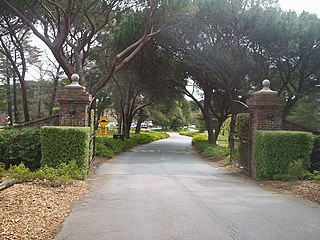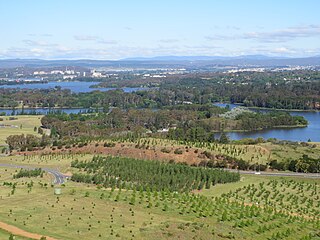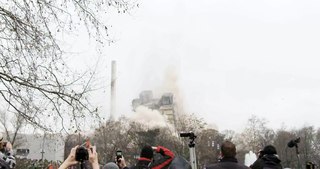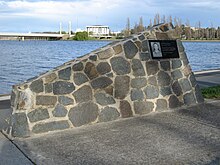
Canberra is the capital city of Australia. Founded following the federation of the colonies of Australia as the seat of government for the new nation, it is Australia's largest inland city and the eighth-largest Australian city overall. The city is located at the northern end of the Australian Capital Territory at the northern tip of the Australian Alps, the country's highest mountain range. As of June 2021, Canberra's estimated population was 453,558.

Anne Katherine Carnell is an Australian businesswoman and former Liberal Party politician, who served as the third Chief Minister of the Australian Capital Territory (ACT) from 1995 to 2000.

The National Museum of Australia, in the national capital Canberra, preserves and interprets Australia's social history, exploring the key issues, people and events that have shaped the nation. It was formally established by the National Museum of Australia Act 1980.

Lake Burley Griffin is an artificial lake in the centre of Canberra, the capital of Australia. It was completed in 1963 after the Molonglo River, which ran between the city centre and Parliamentary Triangle, was dammed. It is named after Walter Burley Griffin, the American architect who won the competition to design the city of Canberra.

The 2003 Canberra bushfires caused severe damage to the suburbs and outer areas of Canberra, the capital city of Australia, during 18–22 January 2003. Almost 70% of the Australian Capital Territory's (ACT) pastures, pine plantations, and nature parks were severely damaged, and most of the Mount Stromlo Observatory was destroyed. After burning for a week around the edges of the ACT, the fires entered the suburbs of Canberra on 18 January 2003. Over the next ten hours, four people died, over 490 were injured, and 470 homes were destroyed or severely damaged, requiring a significant relief and reconstruction effort.

The Canberra Golf Club, later known as the Royal Canberra Golf Club, was formed in 1926. Its original grounds were behind the Hotel Canberra on the river flats on both sides of the Molonglo River.

The Albert Hall is a hall in Canberra, Australia, used for entertainment. It is on Commonwealth Avenue between Commonwealth Bridge and the Hotel Canberra in the suburb of Yarralumla.

Yarramundi Reach is a small peninsula on the western end of Lake Burley Griffin, in the Australian Capital Territory, close to Scrivener Dam. It is also the name for the area of water on Lake Burley Griffin between it and Weston Park.
The history of the Australian Capital Territory (ACT) as a separate administrative division began in 1911, when it was transferred from New South Wales to the Australian federal government. The territory contains Australia's capital city Canberra and various smaller settlements. Until 1989, it also administered the Jervis Bay Territory, a small coastal region.

In the controlled demolition industry, building implosion is the strategic placing of explosive material and timing of its detonation so that a structure collapses on itself in a matter of seconds, minimizing the physical damage to its immediate surroundings. Despite its terminology, building implosion also includes the controlled demolition of other structures, such as bridges, smokestacks, towers, and tunnels.

The Coroner's Court of the Australian Capital Territory is a court which has exclusive jurisdiction over the remains of a person and the power to make findings in respect of the cause of death of a person or fire in Australian Capital Territory.

Canberra Hospital is a teaching hospital is located in Garran, Canberra, Australian Capital Territory. It is the largest district general hospital in the region with 672 beds catering to a population of about 550,000. It was formed when the Woden Valley Hospital and the Royal Canberra Hospital were amalgamated in 1991, and was renamed Canberra Hospital in 1996.

The ANU Medical School (ANUMS) is a graduate medical school of the Australian National University, a public university located in Canberra, in the Australian Capital Territory. Established in November 2003 following accreditation by the Australian Medical Council (AMC), ANUMS commenced offering studies in the Bachelor of Medicine, Bachelor of Surgery program and, under the leadership of the Foundation Dean, Professor Paul Gatenby, the first cohort of students commenced in February 2004. In January 2014 the AMC approved the ANU Medical School changing its medical program to the award of the MChD program.

Sullivans Creek, a partly perennial stream of the Murrumbidgee catchment within the Murray–Darling basin, is located in Canberra, Australian Capital Territory, Australia.
The Immigration Bridge was a proposed footbridge in Canberra, the capital of Australia. It was proposed that it be built between the National Museum of Australia and Lennox Gardens on the south shore of the West Basin of Lake Burley Griffin, in the centre of the city.

Royal Canberra Hospital was the first hospital in Canberra, the capital of Australia. It opened in 1914 on the Acton Peninsula, as the Canberra Community Hospital. It grew to become the major hospital in Canberra before being closed in 1991 and later demolished in 1997.

The Acton Peninsula is located on the northern shore of Lake Burley Griffin, in the centre of Canberra, the capital of Australia.

Black Mountain Peninsula, located in Acton, Australian Capital Territory, a suburb of the capital Canberra, is a prominent area on the western region of Lake Burley Griffin. It is popular for water recreation and picnics.
Marcus de Laune "Marc" Faunce, CVO, AM, OBE, FRCP, FRACP was a Canberra consultant physician, head of Royal Canberra Hospital, doctor to five Australian Prime Ministers and six Governors-General of Australia and former Senior Physician Consultant to the RAAF.
Margaret Anne Hunter is a Special Magistrate of the Australian Capital Territory. She was appointed as a special magistrate and coroner on 21 May 2014.
















